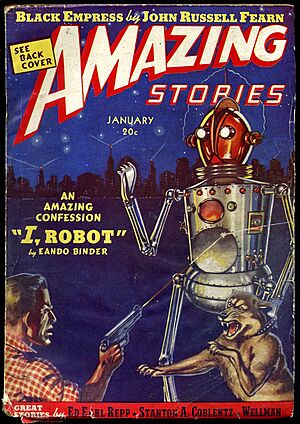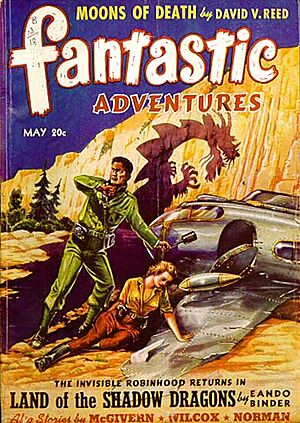Otto Binder facts for kids
Quick facts for kids Otto Binder |
|
|---|---|
 |
|
| Born | Otto Oscar Binder August 26, 1911 Bessemer, Michigan, U.S. |
| Died | October 13, 1974 (aged 63) Chestertown, New York, U.S. |
| Area(s) | Writer |
| Pseudonym(s) | Eando Binder |
|
Notable works
|
Action Comics Adventure Comics Captain Marvel Adventures Mary Marvel Superboy Supergirl Superman "I, Robot" |
| Awards | Kirby Hall of Fame, 1999 Eisner Hall of Fame, 2004 Bill Finger Award, 2010 |
| Relatives | Jack Binder (brother) Earl Andrew Binder (brother) |
Otto Oscar Binder (born August 26, 1911 – died October 13, 1974) was an American writer. He wrote many science fiction and non-fiction books and stories. He also wrote a huge number of comic books.
Binder is best known for helping create Supergirl. He also wrote many stories for Captain Marvel Adventures. He wrote over 4,400 comic stories under his own name. He also wrote more than 160 stories using the pen name "Eando Binder".
Contents
Biography
Early Life and Writing
Otto Binder was born in Bessemer, Michigan. He was the youngest of six children. His family came from Austria and settled in Chicago in 1922. Otto and his brother Earl loved science fiction.
They started writing together. Their first story, "The First Martian," was sold in 1930. It was published in Amazing Stories in 1932. They used the pen name "Eando Binder" for their joint work. This name came from "E" (Earl) and "O" (Otto) Binder.
Otto also worked other jobs to make a living. In 1935, he worked for a literary agent in New York City. During this time, his brother Earl stopped writing with him. From 1936 onwards, all new "Eando Binder" stories were written only by Otto. Otto also wrote for magazines like Thrilling Wonder Stories and Amazing. For Amazing, he created the Adam Link robot series.
Writing for Fawcett Comics
Binder started writing for comic books in 1939. His brother, Jack, was an artist in the comics field. Otto began writing for Fawcett Publications' comic line. He wrote stories for characters like Captain Venture and Bulletman.
After a year, he started writing for Captain Marvel. He soon wrote for other characters in the Marvel Family. These included Captain Marvel, Jr. and Mary Marvel. He helped create Mary Marvel with artist Marc Swayze.
Binder worked at Fawcett from 1941 to 1953. He wrote 986 stories for the Marvel Family. This was more than half of all their adventures! He also helped create characters like Uncle Dudley and Black Adam. He also created Mr. Mind and Tawky Tawny.
Other Comic Book Work
Fawcett Comics closed its comic book division in 1953. But Binder quickly found new work. He wrote for Timely Comics, which later became Marvel Comics. There, he helped create Captain Wonder and Miss America. He also wrote stories for Captain America and the Human Torch.
He also wrote for Quality Comics, where he co-created Kid Eternity. He worked on stories for Blackhawk and Doll Man. For MLJ Comics (now Archie Comics), he wrote about Steel Sterling and the Shield. He also worked for Gold Key Comics, where he co-created Mighty Samson.
Working for DC Comics
In 1948, Binder started working for DC Comics. He created Merry, Girl of 1,000 Gimmicks. He then moved to the Superman comics. He helped launch the Superman's Pal Jimmy Olsen series in 1954.
Binder and artist Al Plastino created the Legion of Super-Heroes. This team of teen superheroes from the future first appeared in Adventure Comics #247 (1958). They also introduced the villain Brainiac and the Bottle City of Kandor in Action Comics #242 (1958).
Binder and Plastino also co-created Supergirl in Action Comics #252 (1959). With other artists, he helped create Krypto the Super Dog and the Phantom Zone. He also created supporting characters like Lucy Lane and Beppo the Super Monkey. In Superman's Pal Jimmy Olsen, he introduced Jimmy's signal-watch. He also gave Jimmy the Elastic Lad identity.
Binder wrote many of the early Bizarro stories. He also wrote the classic story "Superman's Return to Krypton." His last Superman story was in Action Comics #377 (1969).
Books and Later Work
Otto Binder was very interested in the idea of ancient astronauts. He believed that extraterrestrial life existed. He wrote about his ideas in his 1968 book Flying Saucers Are Watching Us. He also wrote Mankind Child of the Stars in 1974. This book talked about the idea that humans might have connections to beings from other planets. He also wrote many articles about UFOs for magazines.
In the early 1960s, Binder faced financial difficulties. He had invested in a magazine called Space World. This magazine was about astronomy, but it did not sell well.
In 1967, a very sad event happened. His daughter, Mary, passed away at age 14 in a car accident. This deeply affected Otto and his wife. They moved to upstate New York. After a difficult time, Otto returned to writing science fiction books. He also wrote articles for magazines like Saga.
In 1973, Binder worked for Pendulum Press. He adapted classic science fiction stories into comic book format. These included Frankenstein, The Invisible Man, and 20,000 Leagues Under the Sea.
Otto Binder passed away on October 13, 1974, in Chestertown, New York. He left behind a huge amount of work. He wrote almost 50,000 pages of comics. This included over 1,300 stories for Fawcett and more than 2,000 for other publishers.
Awards and Legacy
Otto Binder has received many honors for his work. He was added to the Jack Kirby Hall of Fame in 1999. In 2004, he was inducted into the Will Eisner Hall of Fame. He also received the Bill Finger Award in 2010.
Binder is even mentioned in the TV show Supergirl. In the first episode, Supergirl saves a plane from crashing into the "Otto Binder bridge." This shows how important his work was to the world of comics.



